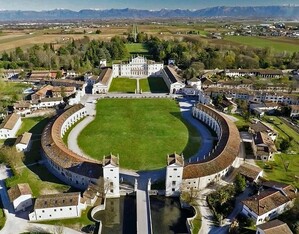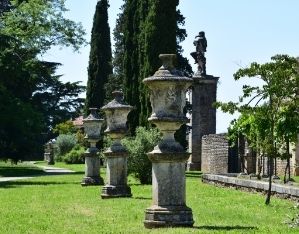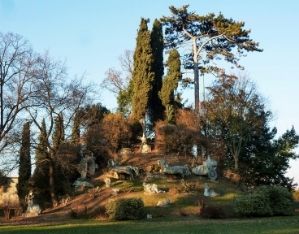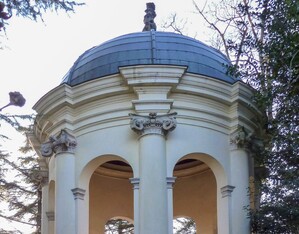During the 19th century, the sumptuous garden of a powerful Doge family was turned into a vast landscaped park: the grandeur and magnificence of the past reflects in the vastness of a once-private property, now managed by the Friuli Venezia Giulia Region, open to the public and home to a variety of events.
Delimited by a high mixtilinear wall, the garden that the prominent Manin family from Venice created for themselves as a way of complementing their majestic residence, today displays varied late-romantic layout. The earliest garden plan, attributed to a French architect of the School of Le Nôtre, dates back to the second decade of the 18th century: the layout was inspired by the Gardens of Versailles and by those of Villa Pisani in Stra, the most splendid Doge residence in the Veneto Region. Over the course of the 18th century, the northern part, delimited by Rococo-style mixtilinear walls, saw various additions including complex hydraulic water features and a considerable statue collection. Visited by illustrious personalities (Maria Amalia of Saxony, Carlo Goldoni, etc.) and backdrop to important political events such as the appointment of Lodovico IV as Doge (1789) and the French occupations (in 1797 the villa became Napoleon’s headquarters in Friuli), Villa Manin’s garden suffered a period of considerable deterioration during the 19th century: in the early 1800s it underwent interventions of formal simplification designed by Giannantonio Selva (the architect responsible for Teatro La Fenice in Venice), while in the 19th century Friulian engineer Pietro Quaglia redesigned the park according to the then-predominating romantic-patriotic trends: the result was the landscape layout still in place today, despite the loss of some of its features. In the 1960s the complex, which had by then became public property, was subject to a greening intervention: numerous plant species were planted, not always harmonising with the pre-existing vegetation. The large tree-lined avenue to the north, set outside the enclosure, is a symbolic representation of the once great power of the Manin family. The same sense of grandeur and influence, attested by historical records and literary sources, also translates in the 18-hectare green area, the earliest example of historical garden in the Friuli Venezia Giulia Region.
Highlights

The exedras
In Passariano, a small town in central Friuli, visitors are usually taken aback by this impressive Baroque-style forecourt, whose curvilinear shape welcomes visitors into one of the most imposing villas of the Veneto Region. The structure, conceived in the 18th century by architect Domenico Rossi, is inspired by Bernini’s colonnade of Saint Peter’s Basilica in Rome. Infused with Venetian luminism this space is a prelude to the splendours of the residence and to the “delights” of the garden behind it.

The frescoes
Almost no trace of the villa’s original sumptuous decorative apparatus remains today, but its past grandeur is evoked in a room leading to the park by an elaborate early-18th-century Rococo fresco decoration by Parisian painter Louis Dorigny: a glorious Triumph of Spring, in the presence of the allegories of Love, Glory, Wealth and Abundance celebrating the illustrious Manin art patrons and ideally introducing visitors to the lush garden that lies beyond.

The sculptures
Adorned with imposing vases and 18th-century garden statuary, the main pathways of the Villa Manin park are named after the most representative and rare plant species growing in it. The elegant Vicenza stone statues are made by specialised workshops of the Veneto Region, one of them being the prestigious Bonazza family and other excellent craftsmen-artists whose work can be admired in many other complexes of the Veneto area.

The hillocks
At the northern end of the park, there are four artificial hillocks adorned with groups of statues representing mythological subjects (Mount Parnassus, The Rape of Proserpina, The Division of the World, Apollo and the Python). These sculptures are all that is left of the original 18th-century garden statuary, today mostly lost. Conceived by Roman scenographer Giuseppe Valeriani, these mythological groups evoke the virtues of noble art patrons and their role as promoters of the arts and the territory.

The small belvedere temple
In the western area of the park, not far from the Doge’s main abode, on an artificial hillock (which once contained the old ice-house) is an Ionic monopteros pavilion. Probably designed by architect Giannantonio Selva, it testifies to the early 19th-century taste shift towards Neoclassicism.
 Villa Manin
Contacts
Villa Manin
Contacts
 Villa Manin
Opening times and prices
Villa Manin
Opening times and prices
Opening hours
- Open every day from 10.00 a.m. to 7.00 p.m.
- Closed on Mondays.
The main body of Villa Manin is closed.
Pricing
Individuals and groups
- Full price: 5,00 €
- Reduced (over 65, under 18 and conventions): 3,00 €.
- Reduced for groups (minimum 15 people): 3,00 €.
- Free of charge: children under 6 years old, disabled accompanying persons, journalists with prior accreditation by e-mail.
Tariff for guided tours
- From € 60.00 to € 100.00
- School groups € 3,00 + € 1,00 each
Guided tours in foreign languages
- on request: English – French – German
 Villa Manin
How to get there
Villa Manin
How to get there
Address
Piazza Manin, 10
33033, Passariano (UD)
Latitude: 45.9488148
Longitude: 13.0070026
How to arrive by road
- From Venice A4 motorway direction Trieste – exit Latisana then direction Codroipo.
- From Slovenia and Croatia you enter Italy at Trieste; take the A4 motorway towards Venice – exit Palmanova; continue towards Codroipo – Pordenone on the SS 252.
- From Austria, enter Italy at Tarvisio; take the A23 motorway to the Udine Sud exit; continue in the direction of Pordenone-Venezia on the SS 13.
How to arrive by bus
Venice-Udine line: get off at Codroipo station. From Codroipo station you can reach Passariano by taxi or bus. We recommend that you check the hours of the trips.
Additional directions
- From the Friuli Venezia Giulia airport of Ronchi dei Legionari (GO) continue by bus to the Ronchi dei Legionari Nord train station, then by train to Codroipo (via Udine).
- From Venice Marco Polo airport by bus to Mestre railway station, then Venice-Udine line to Codroipo.
 Villa Manin
Services/Accessibility
Villa Manin
Services/Accessibility
Services
Pets are allowed.
There is a Bookshop. The opening hours are:
- Tuesday to Friday from 10.30 am to 1.00 pm and from 3.00 pm to 6.30 pm.
- Saturdays, Sundays and holidays from 10.30 am to 1.00 pm and from 1.30 pm to 7.00 pm.
- Monday closed.
- There are two large unguarded car parks to the south of the monumental complex with parking spaces for cars and coaches.
- In the square in front of the villa there are stalls reserved for the disabled.
There are toilets for the disabled at Villa Manin:
- on the ground floor near the entrance of the Villa
- inside the park
You can connect to Wi-Fi.
Some rules of conduct in the Park
- We ask for respect for the environment, for all historical and contemporary artistic artifacts
- We recommend moving along the marked trails.
- It is not allowed to climb artificial hills or trees, pick flowers, mushrooms, fruits.
- In addition, it is forbidden to light fires, camp and bring in bicycles.
- Dogs must be kept on a leash, droppings must be collected.
- Visiting minors must be accompanied by an adult.
- The playground equipment may be used by children under the age of 12 years and under adult supervision.
Accessibility
Accessibility of the Villa
- Villa Manin can be visited by people with reduced mobility thanks to a ramp that facilitates the entrance to the ground floor of the noble body and a lift that leads to the first floor.
- A courtesy wheelchair is available in the bookshop on request.
Accessibility of the Park
- Access to the park for people with reduced mobility and wheelchairs is facilitated by ramps.
- The avenues of the park have a gravel surface that makes them passable by users with reduced mobility and wheelchairs.
 Villa Manin
Private events
Villa Manin
Private events
At Villa Manin it is possible to rent rooms for conferences and meeting rooms.
 Villa Manin
Itineraries
Villa Manin
Itineraries
You could find the garden in these itineraries
 Favorite saving result
Favorite saving result
 Warning!
Warning!
You've have to sign up or sign in to add this element to your favorites.
